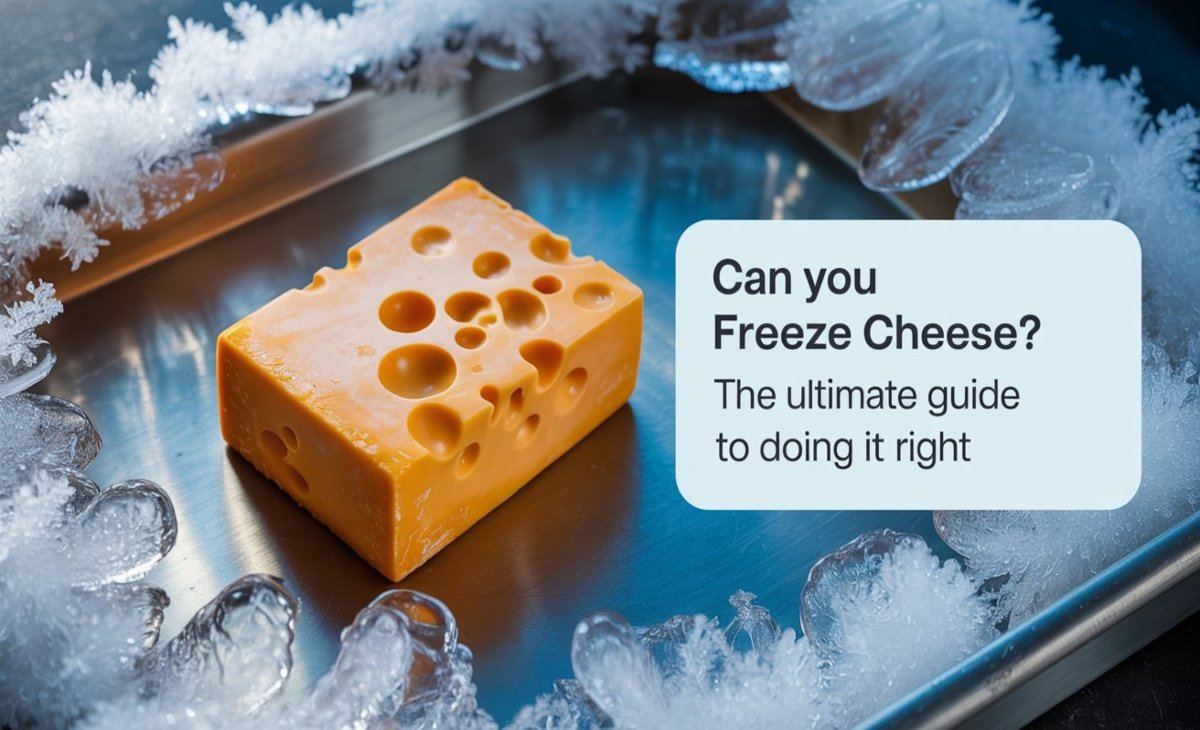If you’ve ever bought a big block of cheddar or stocked up on mozzarella during a sale, you might wonder: can you freeze cheese? The short answer is yes—but it’s not always that simple. While freezing helps extend shelf life and reduce waste, it can also change the texture, flavor, and even how the cheese melts. That’s why knowing which cheeses freeze well (and which don’t) is key to making the most of your dairy stash.
In this guide, we’ll explore how freezing affects different types of cheese, the best (and worst) cheeses to freeze, and step-by-step tips to freeze cheese properly without ruining it.
What Happens When You Freeze Cheese?
Cheese is more than just milk in solid form—it’s a carefully balanced mix of fat, water, proteins, and live cultures. When you put it in the freezer, ice crystals form inside. These crystals can disrupt the cheese’s structure and push out moisture once it’s thawed.
This often leads to:
- A crumbly, drier texture
- Reduced meltability, especially for mozzarella and pizza cheeses stored for long periods
- Flavor changes in softer, ripened cheeses like brie or Camembert
It’s important to note that freezing doesn’t destroy nutrients in cheese. Your cheddar or Swiss will still be packed with protein and calcium after thawing. What changes most is how it feels and tastes when you eat it fresh.
Why Freezing Cheese Matters
For many households, cheese is a kitchen staple. But it’s also expensive, and wasting it feels painful. Freezing cheese gives you three big benefits:
- Longer Shelf Life – Instead of spoiling within weeks, frozen cheese can last 6–9 months.
- Money Savings – Buy in bulk during sales without worrying about waste.
- Convenience – Keep shredded cheese on hand for pizzas, casseroles, and sauces.
However, freezing isn’t a one-size-fits-all solution. Some cheeses bounce back beautifully, while others lose their best qualities.
Best Cheeses to Freeze
Not all cheeses are created equal when it comes to freezing. Generally, hard and semi-hard cheeses do much better than soft, delicate ones.
Cheeses that freeze well include:
- Cheddar – Holds up reasonably well, though it may crumble when sliced.
- Mozzarella & Pizza Cheese – Shredded versions freeze especially well and can be tossed straight into recipes.
- Swiss & Gouda – Good for cooking after freezing, though slicing may be trickier.
- Colby & Monterey Jack – Great options if you plan to use them melted.
Tip: If you know you’ll use frozen cheese in cooked dishes, small textural changes won’t matter as much.
Cheeses You Shouldn’t Freeze
Some cheeses simply don’t handle freezing well. High-moisture and delicate varieties often lose too much of their original character.
Cheeses to avoid freezing include:
- Cottage Cheese & Ricotta – Their creamy texture breaks apart.
- Brie & Camembert – The live cultures that give them flavor are damaged by freezing.
- Parmesan & Romano – Grated versions are better stored in the fridge, where they last up to a year.
- Fresh Cheeses like Queso Fresco or Paneer – Become grainy and watery.
- Processed Cheese & Cheese Spreads – Separation and texture loss make them unappealing.
In short: if a cheese is meant to be enjoyed fresh and creamy, freezing is not the best idea.
How to Freeze Cheese the Right Way
If you decide to freeze cheese, proper preparation is key to preserving quality. Here’s the step-by-step process:
Step 1: Portion It Out
Don’t freeze a whole 2-pound block. Cut cheese into smaller portions or shred it. That way, you can thaw only what you need.
Step 2: Wrap It Properly
Use foil, parchment, or cheese paper. Then place it in an airtight freezer bag or container to protect it from freezer burn.
Step 3: Freeze Quickly
Set your freezer to at least -9 °F (-23 °C). A faster freeze creates smaller ice crystals, which do less damage.
Step 4: Label and Store
Always label your cheese with the freezing date. For the best flavor and texture, use within 6–9 months.
How to Thaw Frozen Cheese
Thawing is just as important as freezing. Done wrong, your cheese can turn rubbery or watery.
- Refrigerator Method: Place cheese in the fridge for 7–8 hours per pound. This slow process helps preserve texture.
- Use Shredded Cheese Straight from Freezer: Perfect for pizza, pasta, or casseroles without thawing.
- Never Refreeze: Once thawed, use it up—refreezing worsens texture and safety.
If cream cheese separates after thawing, try whipping it to restore smoothness.
Expert Tips for Freezing Cheese
- Freeze shredded cheese instead of blocks for best results.
- Always double-wrap to prevent freezer burn.
- Use frozen cheese in cooked dishes like pizza, pasta bakes, casseroles, or grilled cheese.
- Buy smaller amounts of delicate cheeses like brie to enjoy them fresh instead of freezing.
Final Words
So, can you freeze cheese? Yes—but with some caveats. Hard and semi-hard cheeses like cheddar, mozzarella, and Swiss freeze well enough for cooking, while fresh and delicate cheeses lose too much quality. Freezing is a great way to extend shelf life, save money, and reduce waste, especially if you prepare and store your cheese correctly.
If you love cheese at its very best, enjoy soft and artisanal varieties fresh. But if your goal is convenience and less food waste, freezing cheese can be a smart kitchen strategy.
FAQs About Freezing Cheese
Can you freeze cheese without it crumbling?
Hard cheeses like cheddar will likely crumble after freezing. To avoid this, shred before freezing instead of storing large blocks.
How long can you keep cheese frozen?
Cheese stays safe indefinitely in the freezer, but for the best quality, use it within 6–9 months.
Can frozen cheese still melt?
Yes, but it won’t melt as smoothly. Frozen mozzarella, for example, may not stretch the way fresh mozzarella does.
Is freezing cheese safe?
Absolutely. Freezing inactivates microbes like mold and bacteria, making cheese safe to store for longer. Just remember, thawing reactivates them, so eat promptly after defrosting.





